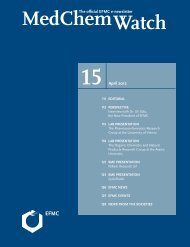You also want an ePaper? Increase the reach of your titles
YUMPU automatically turns print PDFs into web optimized ePapers that Google loves.
odds with open innovation, perhaps the<br />
only concept at odds with open innovation<br />
is exclusivity. As soon as an idea is<br />
exclusively owned and controlled its potential<br />
to evolve is greatly diminished.<br />
Going back to the ecosystem analogy, it<br />
is in effect removed from the gene pool.<br />
Why Open Innovation is not an easy<br />
option<br />
Open innovation has been widely recommended<br />
as a fix-all solution to poor<br />
productivity in pharma, but there are<br />
a few fallacies about the concept that<br />
should be considered, as they could<br />
potentially lead to a future backlash<br />
against the concept. The first is that<br />
an open innovation strategy can be implemented<br />
exclusively by specialists in<br />
legal, IP and business development.<br />
Although there is clearly an important<br />
role for such specialists in seeking innovation,<br />
negotiations and deal making,<br />
arguably many of the failings of<br />
open innovation to date have been related<br />
to the failure to involve “hands<br />
on” internal domain experts in the evaluation<br />
of external technologies. A very<br />
recent example, being the relative failure<br />
of GSK to translate compounds and<br />
tools acquired from the biotech company,<br />
Sirtris 5 . This seems to be a trend in<br />
Pharma, where the critical mass of disease<br />
or technological expertise, in the<br />
traditional “therapeutic area” has been<br />
dispersed in favour of opportunistic<br />
externally facing drug discovery units<br />
and venture units. The success of this<br />
concept relies heavily on the excellence<br />
of the staff leading the external facing<br />
units and perhaps uncovers a paradox<br />
of the open innovation concept. That is<br />
that the best Innovators tend to be very<br />
active (“hands on”) in their field, but an<br />
open innovation strategy, by focusing<br />
externally rather than internally, may<br />
not favour “hands on” involvement in<br />
the innovation process. This argues<br />
for a very tight partnership between<br />
specialist “innovation seekers” and the<br />
internal innovators (read ordinary lab<br />
scientists) who can ensure the translation<br />
of external ideas into internal<br />
successes. So it follows therefore, that<br />
open innovation has the best potential<br />
to work within the pre-existing R&D<br />
framework of organisations. The emphasis<br />
here is on organic growth and<br />
cultural change within organisations,<br />
rather than radical solutions and restructuring.<br />
Success of this strategy is<br />
in many cases dependent on the visibility<br />
of “external innovations” within and<br />
across fields, so that they can be recognised<br />
and adopted. This is probably the<br />
biggest challenge for a successful open<br />
innovation strategy.<br />
Publicise or die...<br />
Although the traditional patent document<br />
is the conventional route to describe<br />
and protect innovation, without<br />
other publicity strategies it can be a serious<br />
barrier to open innovation. This<br />
is not in terms of the intellectual property<br />
clai<strong>med</strong>, but due to the tendency of<br />
patent documents to obfuscate claims,<br />
either intentionally or unintentionally 6 .<br />
Publication is the most widely used<br />
mechanism for publicising innovation,<br />
usually after intellectual property (IP)<br />
has been secured. But a publication focused<br />
strategy brings with it real problems<br />
for innovation seekers. Foremost<br />
among these is the peer review process<br />
itself, which can introduce multiple biases<br />
into the published literature corpus<br />
7 . For example, the so-called “Matthew<br />
effect” has been well documented,<br />
showing that reviewers and editors tend<br />
to be much more favourable in their<br />
evaluation of manuscripts submitted<br />
by “famous investigators” from prestigious<br />
institutions, regardless of the<br />
MEDCHEMWATCH NO.14 DECEMBER 2011<br />
manuscripts’ scientific and technical<br />
merit 7 . The high impact and palpable<br />
excitement in the literature surrounding<br />
resveratrol 8 , undoubtedly played<br />
a role in the acquisition of Sirtris for<br />
$720 million. The issues with peer review<br />
also make it comparatively much<br />
more difficult for new investigators, or<br />
investigators in new fields to publish<br />
in high impact journals. Also at a more<br />
fundamental level, some really great innovations<br />
may not be considered worthy<br />
or substantial enough to support<br />
high impact publication alone. Instead<br />
they need to be recognised and adopted<br />
within the wider translational research<br />
process to show their true value.<br />
Does Crowd Science have a place in<br />
drug discovery?<br />
Crowd Science is a key open innovation<br />
concept to improve the visibility of<br />
the needs of innovators and innovation<br />
seekers. The concept has been implemented<br />
in many different ways, two key<br />
implementations of crowd science are<br />
considered here. From the point of view<br />
of innovation seekers, “crowd sourcing”<br />
is a process where tasks traditionally<br />
perfor<strong>med</strong> by specific individuals are<br />
opened up to a group of people or community<br />
(crowd) through an open call.<br />
Research funding agencies are already<br />
working in this way when they release<br />
a call for proposals in a specific research<br />
area. The other concept to consider<br />
from the point of view of those wishing<br />
to publicise their skills or innovations,<br />
is “crowd funding”. This describes an<br />
open call process to collectively support<br />
specific efforts initiated by other people<br />
or organisations.<br />
Both approaches have already been applied<br />
to aspects of drug discovery with<br />
some success. A good example of the<br />
crowd funding approach is DrugDev.org<br />
(Table 1), which uses social networking<br />
MCW 93





